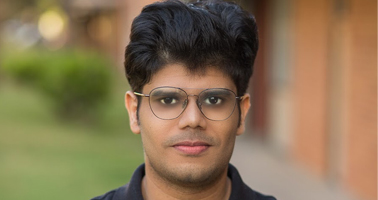Past Event: PhD Dissertation Defense
Dhwanit Agarwal, CSEM PhD Student, Oden Institute, UT Austin
10:30 – 1PM
Monday Mar 21, 2022
ZOOM Only
** This defense will be ZOOM Only**
In this dissertation, we study Stokesian particulate flows. In particular, we are interested in the dynamics of vesicles and red blood cells (RBCs) suspended in Stokes flow. We aim to develop mathematical models and numerical techniques for accurate simulation of their dynamics in microcirculation. Vesicles are closed membranes made of a phospholipid bilayer and are filled with fluid. Red blood cells are highly deformable nucleus-free cells and have rich dynamics when subjected to viscous forcing. Understanding single RBC dynamics is a complex fluid-membrane interaction problem of fundamental importance in expanding our understanding of red blood cell suspensions. For example, one of the fundamental problems is the construction of phase diagrams for the red blood cell shapes as a function of the imposed flow and the mechanical properties of the cell. Accurate knowledge of their shape dynamics has also led to interesting approaches for cell sorting based on mechanical properties in lateral displacement devices.
We model an RBC using two different models, namely, ``vesicle" and ``capsule". We use the term particle to refer to both of them. Vesicles are inextensible surfaces with bending resistance and serve as a good model for RBC in 2D. But in 3D, vesicles miss important features of RBC dynamics because they have zero shear resistance. In contrast, an inextensible capsule resists shear in addition to the bending and is a more accurate model of RBC in 3D. For both the particles, we use a boundary integral formulation to simulate their long time horizon dynamics using spherical harmonics based spectral singular quadratures, differentiation and reparameterization techniques. We demonstrate the full relevance of our simulations using quantitative comparisons with existing experimental results with RBCs and vesicles. Once we have verified and validated our code, we use it to study the bistability (two RBC equilibrium states depending on initial state of RBC) observed under same flow conditions in our simulations. We plot the phase diagrams of equilibrium shapes of vesicles and RBCs in confined and unconfined Poiseuille flow.
Finally, we also develop a novel scheme for Stokesian particle simulation using regularized Stokes kernels and overset finite differences based on overlapping patchwise discretization of the surface. Our scheme has lower work complexity than the spherical harmonics based scheme and also exhibits a high order convergence (typically fourth order) than the quadratic convergence of the triangulation based schemes . Furthermore, the patchwise discretization approach allows for more local independent control over resolution of the different parts of the surface than the global spherical harmonics based scheme. We verify this new scheme for extensible capsule simulation by quantitative comparison with the previous results in the literature for extensible capsules. We also demonstrate easy acceleration of singular quadrature using all-pairs evaluation algorithm implemented for the GPU architecture. The GPU acceleration allows us to do long time horizon simulation of capsules of low reduced volume resulting in complex shapes. Our scheme is also easily accessible to further acceleration using the fast multipole methods (FMMs).
Dhwanit Agarwal is a CSEM PhD candidate who received his B.S.in Mathematics from the Indian Institute of Technology Kanpur. He has 4+ years experience in multidimensional data analysis, multivariate optimization and numerical analysis, experience in machine learning with packages like PyTorch, Scikit and R., and has strong mathematical and quantitative skills. He is enthusiastic about science, philosophy, and mathematics. He served as a Data Scientist Intern at Adobe May-August 2021 and as a Computational Scientist Intern at Simons Foundation June-August 2020.
